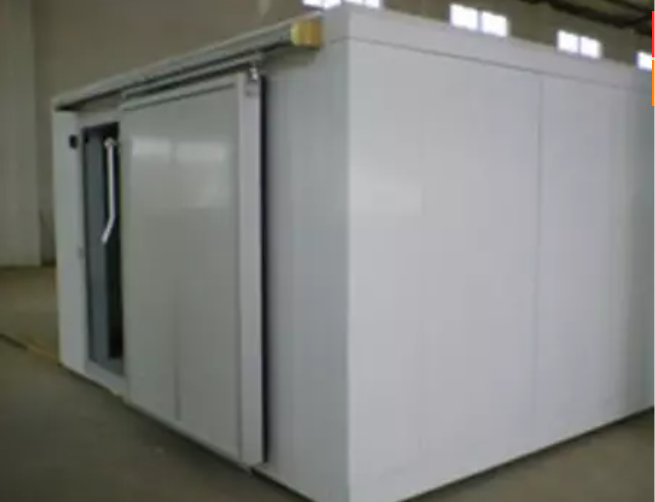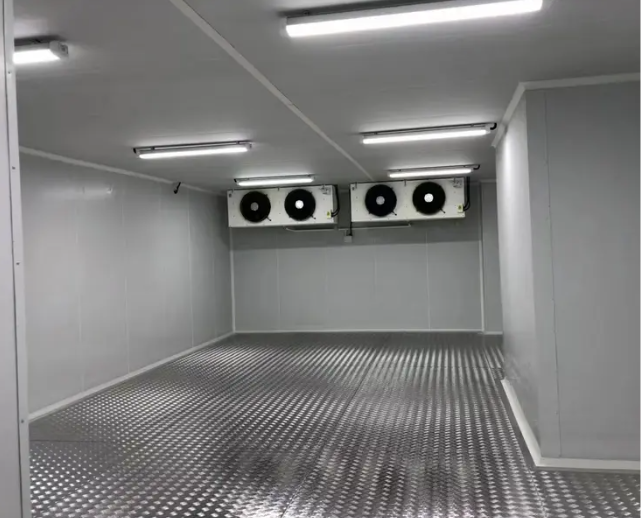Ever wondered about the difference between a cold room and a cool room? While these terms are often used interchangeably, they have distinct functions and applications. In this post, we'll clarify the differences between cold rooms and cool rooms, helping you choose the right storage solution. You'll learn about their temperature ranges, uses, and the industries that rely on each.
What are Cold Rooms and Cool Rooms?
What is a Cold Room?
A cold room is a specialized refrigeration unit designed to maintain low temperatures for storing perishable goods. It plays a critical role in ensuring long-term storage of items that need freezing, like meats, seafood, and ice cream.
Key Features of Cold Rooms
● Insulation: Cold rooms are equipped with high-quality insulation, ensuring minimal temperature fluctuation.
● Humidity Control: Proper humidity regulation prevents freezer burn and ensures the goods remain in optimal condition.
● Energy Consumption: Due to the low temperature requirements, cold rooms tend to consume more energy than other types of storage rooms.

What is a Cool Room?
A cool room is a refrigerated space designed to maintain moderate temperatures for short to medium-term storage. Unlike cold rooms, cool rooms don’t freeze items but instead keep them cool, preserving the freshness of products.
Key Features of Cool Rooms
● Insulation: Cool rooms use insulation to block heat from entering, maintaining moderate temperatures.
● Humidity Regulation: They ensure the right moisture levels to keep products fresh.
● Energy Efficiency: Since cool rooms don’t need to maintain freezing temperatures, they are more energy-efficient than cold rooms.

Key Differences Between Cold Rooms and Cool Rooms
Temperature and Purpose
Cold rooms are built to maintain freezing temperatures, typically ranging from -18°C to -25°C. These extreme temperatures are essential for preserving frozen goods like meats, seafood, and ice cream. Cool rooms, on the other hand, maintain moderate temperatures between 2°C to 8°C. They are ideal for storing fresh items, such as fruits, vegetables, and dairy products.
The temperature difference directly affects what can be stored. Cold rooms are perfect for long-term storage of products requiring freezing, while cool rooms are better for products needing cooling without freezing.
Storage Duration
Cold rooms are designed for long-term storage. Frozen foods and pharmaceuticals can stay stored for extended periods without risk of spoilage. Cool rooms are intended for short to medium-term storage, often used for products that need frequent access or quicker turnover, like fresh produce in grocery stores or restaurants.
Insulation and Construction
Cold rooms require thicker, more robust insulation to keep the temperature consistently low and prevent heat from entering. This ensures the freezing temperatures stay stable. In contrast, cool rooms have less intense insulation because they only need to maintain moderate temperatures. The insulation is still important, but not as thick as cold rooms.
Energy Consumption
Because cold rooms maintain much lower temperatures, they consume more energy. The cooling systems must work harder to keep the space freezing, leading to higher energy costs. Cool rooms are more energy-efficient, as their cooling systems don’t need to maintain extreme temperatures, making them less demanding on energy usage.
Applications
Cold rooms are commonly used in food distribution centers, pharmaceutical storage, and ice cream manufacturing, where freezing is crucial. Cool rooms are typically found in grocery stores, hotels, restaurants, and medical facilities, where storing fresh items like fruits, flowers, and medications at moderate temperatures is required.
Feature | Cold Room | Cool Room |
Temperature Range | -18°C to -25°C | 2°C to 8°C |
Purpose | Long-term storage of frozen goods | Short to medium-term storage of fresh goods |
Energy Consumption | Higher energy usage | More energy-efficient |
Applications | Food distribution, pharmaceuticals, ice cream | Grocery stores, restaurants, hospitals |
Insulation | Thicker, robust insulation | Moderate insulation |
This comparison highlights the main differences in their temperature, usage, and energy requirements.
The Role of Cold and Cool Rooms in Different Industries
Food Industry
Cold rooms play a crucial role in the food industry, particularly for storing frozen goods. Items like meats, seafood, ice cream, and frozen vegetables need to be stored at freezing temperatures to maintain their quality over time. Cold rooms are ideal for the long-term storage of these products.
Cool rooms, however, are used for storing fresh produce, dairy products, and other perishable items that don't require freezing. These rooms maintain moderate temperatures to keep the items fresh while reducing spoilage.
Food Item | Storage Type | Temperature Range |
Meats, Seafood, Ice Cream | Cold Room | -18°C to -25°C |
Fruits, Vegetables, Dairy | Cool Room | 2°C to 8°C |
Pharmaceutical Industry
The pharmaceutical industry relies heavily on cold rooms to store temperature-sensitive medications and vaccines. Many drugs need to be stored at freezing temperatures to maintain their efficacy and safety. Cold rooms provide an essential solution for this.
For pharmaceutical products that don't require freezing but need to stay cool, cool rooms offer short-term storage. This includes medications that must be stored between 2°C and 8°C to ensure their effectiveness.
Retail and Supermarkets
In retail and supermarket environments, cool rooms are commonly used to store fruits, vegetables, and ready-to-eat meals. These items need to remain at a consistent, cool temperature to stay fresh and maintain their quality for customers.
Cold rooms may also be used in large food distribution centers within supermarkets, particularly for frozen foods, but cool rooms are essential for everyday fresh goods.
Hotels, Restaurants, and Catering
In the hospitality industry, such as hotels, restaurants, and catering services, cool rooms are crucial for storing fresh ingredients like meats, dairy, and vegetables. These ingredients need to be kept at the right temperature to prevent spoilage, ensuring they are safe for consumption.
The cool rooms prevent food waste and allow businesses to store ingredients at a controlled temperature, helping them to manage inventory and provide high-quality meals to customers.
Summary
Industry | Storage Type | Items Stored |
Food Industry | Cold Room | Frozen foods, meats, seafood |
Pharmaceutical Industry | Cold Room | Medications, vaccines |
Retail & Supermarkets | Cool Room | Fruits, vegetables, meals |
Hotels & Restaurants | Cool Room | Fresh ingredients |
Choosing the Right Room for Your Needs
Factors to Consider When Choosing Between Cold and Cool Rooms
When deciding between a cold room and a cool room, you need to consider the type of products you’re storing. If you're dealing with frozen items like meats or ice cream, a cold room is necessary. For fresh produce or dairy, a cool room is ideal as it keeps things at moderate temperatures.
Next, think about the duration of storage. Cold rooms are perfect for long-term storage, especially for products that need freezing. Cool rooms, however, are best for short-term or medium-term storage where items are accessed frequently.
Another crucial factor is your energy budget. Cold rooms consume more energy to maintain freezing temperatures, whereas cool rooms are more energy-efficient, making them a better choice for businesses with lower operational costs.
How to Decide Based on Your Business Needs
For businesses in the food industry, you’ll want a cold room for frozen goods and a cool room for fresh produce and dairy. In medical facilities, cold rooms are essential for temperature-sensitive medications or vaccines, while cool rooms can store pharmaceuticals needing moderate cooling.
If you run a hotel, restaurant, or catering business, cool rooms will be ideal for storing fresh ingredients and preventing spoilage, while also helping to manage inventory and avoid waste.
Industry | Cold Room | Cool Room |
Food Industry | Frozen food storage | Fresh produce, dairy |
Pharmaceutical Industry | Medications, vaccines | Short-term storage of meds |
Hospitality (Hotels, Restaurants) | Not required | Fresh ingredients storage |
Cost Considerations
Cold rooms are generally more expensive due to their construction, thicker insulation, and higher energy consumption. Cool rooms are more affordable, especially for businesses looking to keep costs down, as they are energy-efficient and need less intensive cooling.
Room Type | Construction Cost | Energy Consumption |
Cold Room | Higher | Higher |
Cool Room | Lower | Lower |
Choosing the right type of room for your business comes down to the type of products you need to store, how long you need to store them, and how much you're willing to spend on energy and construction costs.
How to Maintain Cold and Cool Rooms
Maintenance Tips for Cold Rooms
Maintaining cold rooms is essential to keep your frozen goods at the correct temperature. Here are some key tips:
● Regular Temperature Checks: Always monitor the temperature inside the cold room. Use reliable thermometers or automated systems to ensure it stays within the required range of -18°C to -25°C.
● Insulation Inspections: Check the insulation regularly for any damage or wear. Poor insulation can cause temperature fluctuations, leading to potential spoilage or energy inefficiency.
● Prevent Freezer Burn: To prevent freezer burn, ensure your cold room maintains the correct humidity and temperature levels. Use humidity control systems and avoid frequent door openings.
Tip | Why It's Important |
Regular Temperature Checks | Ensures consistent cold storage |
Insulation Inspections | Prevents heat leaks and energy waste |
Humidity Control | Maintains product quality and prevents freezer burn |
Maintenance Tips for Cool Rooms
Cool rooms, while easier to maintain than cold rooms, still need attention. Follow these tips to keep things running smoothly:
● Cooling System Checks: Regularly inspect the cooling system to ensure it’s working efficiently. Make sure filters are clean and the compressor is running properly.
● Manage Humidity: Humidity plays a critical role in keeping fresh products like fruits and vegetables in good condition. Use humidity regulation systems to prevent excess moisture or dryness.
● Avoid Temperature Fluctuations: Even small fluctuations can cause spoilage in fresh goods. Ensure the cool room maintains a consistent temperature, ideally between 2°C to 8°C.
Tip | Why It's Important |
Cooling System Checks | Ensures proper functioning and prevents breakdowns |
Humidity Regulation | Keeps products fresh and prevents mold or wilting |
Temperature Consistency | Maintains product quality and extends shelf life |
Troubleshooting Common Issues
Over time, both cold and cool rooms can experience issues. Here’s how to tackle the most common problems:
● Temperature Fluctuations: If you notice the temperature rising or falling unexpectedly, check the thermostat and doors. Make sure the doors seal tightly and aren’t left open too often.
● Energy Inefficiencies: If your energy bills are higher than usual, inspect the insulation and ensure that the cooling unit isn’t working harder than it should. Sometimes cleaning the condenser coils can help improve efficiency.
● Improper Humidity Control: If humidity is too high or low, check the humidity control system. You may need to adjust the settings or clean the filters.
Issue | Solution |
Temperature Fluctuations | Check seals, doors, and thermostat settings |
Energy Inefficiency | Inspect insulation and clean cooling units |
Humidity Control Problems | Adjust or clean the humidity system |
Conclusion
Cold rooms and cool rooms serve different purposes. Cold rooms maintain freezing temperatures (-18°C to -25°C) for long-term storage, while cool rooms keep moderate temperatures (2°C to 8°C) for short-term storage.
When choosing between the two, evaluate your specific storage needs. Consider the type of products, storage duration, and energy budget. Businesses should select based on product type and their cooling requirements.
FAQ
Q: What is the temperature range for cold rooms and cool rooms?
A: Cold rooms operate between -18°C to -25°C, while cool rooms range from 2°C to 8°C.
Q: Which room is more energy-efficient?
A: Cool rooms are more energy-efficient due to their higher temperature range.
Q: Can a cold room be used for short-term storage?
A: Cold rooms are designed for long-term storage, but they can store items temporarily if needed.
Q: Why is humidity control important in cold and cool rooms?
A: Cold rooms need humidity control to prevent freezer burn, while cool rooms maintain product freshness by managing moisture.



